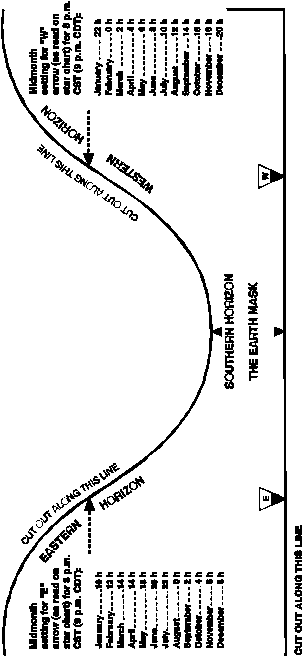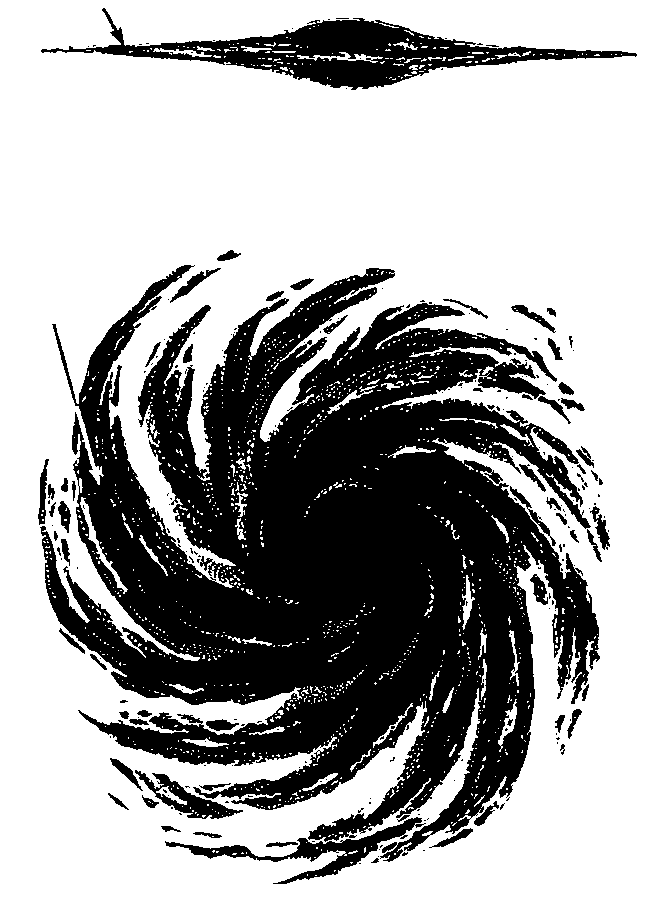

To recognize that the Milky Way is the disk of a galaxy that extends around the sky. In one of its spiral arms the Earth, and all of us, reside.
To modify the rectangular star chart so that it will show the night sky as it appears from earth at any time and date of the year and to locate the objects which the KAO will observe
Ask students if anyone has ever seen the Milky Way. Ask students what they think the Milky Way is.
Hold up a paper dinner plate. Explain that the earth and sun belong to a huge star system called a galaxy, an aggregation of over 100 billion stars bound together by gravity, and that the galaxy has roughly the shape of a plate. In the center of the plate draw a circle and spirals swirling out from it. Explain that the stars in our Milky Way Galaxy are arranged in spiral arms and that the sun is embedded inside one of the spiral arms.
Materials
Procedure Read the instructions with students. Locate the band of the Milky Way as it snakes across the star field. Plot the locations of the KAO's targets on the star chart. Identify which objects lie on, near, or in the band of the Milky Way. Then ask students to cut out the star charts and roll them into a tube with the illustration on the inside. Tape the tube so that the pattern overlaps itself. Ask them to imagine the earth in the center of the tube, and Earthling-astronomers looking out at the stars. Help students realize that the Milky Way is a band that completely encircles our planet.
Cut a hole in the plate about two-thirds from the center, in the middle of one of the spiral arms you've already drawn. Place the clay earth inside the hole. Show that the "Milky Way plate" becomes a disk surrounding the clay earth.
Materials
Procedure Cut out the horizon mask. Place it over the star chart so that it matches the small reference diagram. Set the "E" marker on the mask to 4 hours and the "W" marker to 16 hours. By sliding the mask to the left, you can change the star field to one for later in the evening.
Explain that the star chart used in activity 1G page 27 does not always match the sky overhead. In this activity, students will make a horizon mask that converts the chart into a representation that provides a guide to the sky outside.
Once students know how to place the mask over the star chart, they can adjust it to match the sky when the KAO takes off, at midnight Eastern time, or when it lands.
KAO Connection
The Milky Way and the clouds of dust and gas in its spiral arms block light from distant stars. Infrared and radio waves, however, can penetrate these clouds. The KAO astronomers will, in fact, observe just such a star cloud called W51, hidden by the arms of the Milky Way in visible light but easily found at infrared wavelengths.
The earth hides all the stars below the horizon. Cut out the mask
below and place it over the star chart on page 27. This
mask will block out the stars that are below the horizon for any
date and time.These arrows:  should point to numbers along the
bottom of the star chart. This is the Right Ascension (RA) scale
on the chart. Use these numbers to position the mask correctly
for any time of year. The table on the mask gives the correct
location for 8 p.m. standard time or 9 p.m. daylight savings time.
should point to numbers along the
bottom of the star chart. This is the Right Ascension (RA) scale
on the chart. Use these numbers to position the mask correctly
for any time of year. The table on the mask gives the correct
location for 8 p.m. standard time or 9 p.m. daylight savings time.


Position the star mask over the star chart, as in the diagram
above.

Our solar system lies in a vast galaxy of over a hundred billion stars called the Milky Way. This name also applies to the band of hazy light stretching across the heavens, as seen from earth. This milky band marks the disk of the Milky Way Galaxy with its dusty spiral arms. We are located on the inside of our galaxy's Orion arm. When we face the constellation Orion, we are looking outward, away from the galaxy's center. The Sagittarius arm lies between us and the center of our galaxy. When we look toward Scorpius and Sagittarius, we are facing the galaxy's center which is hidden in dusty clouds. Shade the Milky Way band on the star chart.
Cut out the star chart and curl it into a cylinder. Overlap the repeating star patterns. Imagine the earth at the center of the cylinder. Notice that Orion and Sagittarius are opposite each other in the Milky Way.
KAO Corner:
Most KAO flights last over 7 hours. During that time the earth spins and the star field changes. To watch how the star field will change, just move your mask horizontally to the left. When you increase the numerical setting by one hour, the chart will show the night sky one hour later. For 9 p.m. standard time, move the mask one hour to the left. For 10 p.m. move the mask 2 hours to the left. For 3 a.m. move the mask 7 hours to the left. In October, the left arrow should be over the 4 hrs reading. The right arrow should be over the 16 hrs reading.
KAO Corner:
The dashed curved line running along the star chart is the ecliptic or plane of the solar system. The sun, moon, and planets are always found on or near this line. Plot the locations for Jupiter and Saturn during the KAO flights.
Jupiter on October 12, 1995: RA: 16h 44m DEC: -21(deg)45' Saturn on October 13, 1995: RA: 23h 24m DEC: -06(deg)26'
KAO Corner
During its night flight to the stars, the KAO is scheduled to observe the following objects. Plot each object on the star chart and decide if it is in the plane of the galaxy or above it.
| Object | Right Ascension | Declination |
| M17 | 18h20m | -16(deg)12' |
| M33 | 1h34m | +30(deg)38' |
| M57 | 18h53m | +33(deg)01' |
| W51 | 19h23m | +14(deg)30' |
![]()